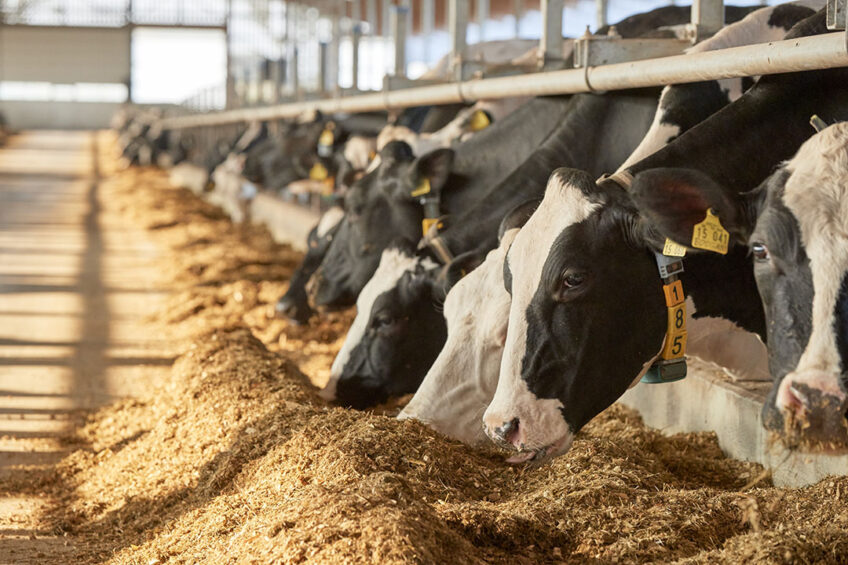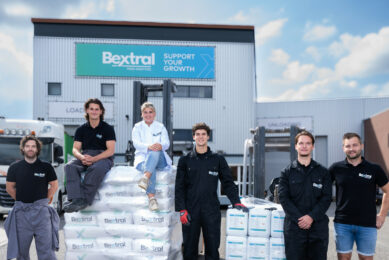Methionine is much more than milk protein

Protected methionine can be a valid tool to improve health and performance. This article provides an overview on the metabolic roles of this amino acid, when it can be profitable to use, and what you can expect from it.
Cows do not have a requirement for Crude Protein (CP) or Rumen Undegradable Protein (RUP, bypass). The rumen uses Non Protein Nitrogen (NPN) to synthesise high-quality microbial protein that will supply the largest part of the Metabolizable Protein (MP). High-producing cows have a higher need of amino acids arriving at the intestine than their rumen can provide. Covering this extra requirement by supplying more CP results in increasing supplies of both Rumen Degradable and Undegradable Protein and comes with high environmental, economic and health cost.

Studies show it is possible to achieve the same, or higher, milk yield with lower CP by using a nutritional strategy based on a combination of maximising production of microbial protein coupled with the use of protected amino acids to cover the needs for amino acids. This approach comes along with lower feed costs and higher Income Over Feed Cost. The 2 first limiting amino acids for milk production are methionine and lysine, due to their low concentrations in feed protein and high concentration in milk. Methionine has a big focus in dairy cow research because of its important metabolic roles. These extra benefits in terms of cow health can be even more important than the direct effect on milk production or milk protein yield.
Methionine: A functional amino acid
Research shows methionine fed pre-fresh and post-fresh affected post-calving metabolism through increased liver functionality, neutrophil function and insulin, while decreasing oxidative stress, inflammation and circulating Non Esterified Fatty Acids (NEFAs). This is likely explained through an increase of taurine and glutathione in the liver, what causes a reduction of oxidative stress and, therefore, cytokines. Decreased cytokine levels lead to lower satiety signals which leads to higher feed intake. Reproduction is also affected by methionine supplementation. Cardoso (WDMC, 2017) communicated a reduction of pregnancy losses from 28 to 61 days after artificial insemination from 19.6% to 6.1% on multiparous cows when top-dressing protected methionine on a basal diet with 6.9% mLys and 1.87% mMet in MP. Recommendations have been published and updated in the past, with a trend for higher methionine concentrations in MP (Table 1).
When there is more demand for energy than for amino acids, the liver diverts amino acids towards energy supply. For example, the foetus depends on amino acids for up to 50% of its glucose, and so does the periparturient cow. It makes sense to correlate amino acid requirements to energy, and indeed, the latest recommendations follow this pattern.
- Target 1.12-1.15 g mMet/Mcal ME
- Keep Lys/Met ratio at 2.7
- Calculate Lys requirements (calculate Met first, then Lys)
The first step when formulating is to maximise the output of energy and microbial protein from the rumen. - Balance on Energy Corrected Milk
- Keep rumen N over 115% of requirement to cover rumen needs
- Maximise microbial MP with fermentable CHO
- Keep Lys/Met ratio at 2.7
Different methionine supplements
Methionine supplements can be divided into lipid matrix and coat protected products. Lipid matrix sources rely on fat as the carrier of the methionine. They are cheaper than coat protected products, deliver a lower payload of methionine and have limited post-ruminal release and absorption. Therefore, most nutritionists and producers rely on coat protected methionine sources rather than lipid matrix products. True protected methionine products rely on a coat protection to bypass the rumen. The most known products worldwide are Mepron with ethylcellulose coating and pH sensitive rumen protected methionine (RPMet). Different products rely on different coatings and methods of releasing the methionine. Mepron works based on soaking and abrasion and releases methionine slowly, whereas pH sensitive RPMet releases methionine quickly in the abomasum. The quick release of pH sensitive RPMet causes a very marked but short-term methionine spike in the blood. Ethylcellulose coated RPMet with its slow-release properties causes no spike, but elevated methionine blood concentrations over a longer period. There is no correlation between the blood spike attained with pH sensitive RPMet and higher milk protein yields.
A study on market-available protected methionine products involving both pH sensitive and ethylcellulose RPMet is the meta-analysis published by Patton involving a database of 36 studies (Table 2). Cows fed Mepron produced more milk protein (37 vs 16g) and more fat (24 vs -2g) than those fed with pH sensitive RPMet. Cows fed Mepron also increased milk production (350 g/d) whereas those fed pH sensitive RPMet showed a reduction (-220 g/d). Mepron-fed cows increased milk protein yield and milk fat yield, as well as total milk production. Also, with higher milk production a dilution effect occurs. This means milk protein % is not sufficient to discriminate among products, and likely total production of milk protein or Energy Corrected Milk (ECM) are better measures of product performance.
Knowing your product
Use of rumen-protected methionine, coupled with maximising microbial protein, is a valid strategy to increase milk production and farm profitability. Be aware of other possible metabolic roles of methionine that could disguise the beneficial effect of the amino acid, and bear in mind the importance of an adequate supply of energy as the first condition to successfully implement the use of protected amino acids. Choosing a reliable source of protected methionine is not easy. A product must be supported by abundant reliable scientific literature demonstrating its effects, and a long-time presence in the market, so practical experience is important. Methionine blood concentrations can be misleading, and it is not advisable to choose products based on it. A high blood concentration ‘spike’ only gives information about how methionine is released by a product, but a lower, more sustainable elevated blood methionine concentration is more desirable. Available meta-analyses show consistent, improved practical results by products following this strategy.
Authors: Dairy consultant Luis Cardo, DVM, and Dr Claudia Parys,Technical Service Manager Ruminants, Evonik
Join 13,000+ subscribers
Subscribe to our newsletter to stay updated about all the need-to-know content in the dairy sector, two times a week.






